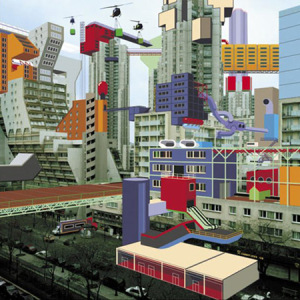In an increasingly digital world where information systems are operating at a much higher level of transparency and where knowledge is uploaded and downloaded readily regardless of geographic location, it is critical for architects to push the redefinition of tools which are at their disposal in a way that is relative to the environments in which they are being deployed. Somewhat ironically, this phenomenon tends to imply a lack of, or deconstruction of definition rather than a clarity of architectural methods and practices. To further this confusion, just as the technologies in our world are continually changing, we ourselves are on an evolutionary path in terms of our perception of space, sound and scale. The disconnection lies in the conflicting identities of the ‘people’ and the ‘city’. Technology plays an important role in these identities, but is defined in an additive fashion, as opposed to one which is integral. This idea of the position of technology within the dual identities of the people and the masses is touched on by Toyo Ito in “Tarzans in the Media Forest”, where he explains shifts in his ideology through the use of personal experience.
In the text, he identifies the parallels between ecological networks in wilderness, and socio-political networks in capitalist societies, claiming that they operate in similarly competitive and sensitive ways, but produce far different results based on their process. In the ecological example, Ito writes that thriving ecosystems are identified not by the peaceful coexistence of trees and shrubs, but rather by the perpetual competition and reciprocal battles between different species. Challenge leads to adaptation, an innate potential which is built into trees and plants, and exemplified by their fractal shape. He goes on to explain that although the ‘image’ of the ideal tree is imprinted within the DNA, growth remains open to environmental changes and relationships with other species. As such, the tree deploys a simple algorithm for expansion and growth which is developed through innumerable empirical tests in its immediate environment. On the contrast, he implies that due to the persistent presence of an architectural ‘image’ or ideology related to the finished product, built environments in the capitalist society are unable to form a similarly relational logic with their environment. In this comparison, he places technology as the intermediate which can promote the complexity that is inherent in our interactive environments, through adhering to simple geometric rules that are reflective to those of trees. He uses a back-to-basics principle in order to position himself in a place where he can ask certain fundamental questions about architecture in order to deconstruct and rebuild his own ideology for practice.
The deconstruction of ideology and the redefinition of technology are two points which drive most of his article, and the delivery of his personal experience as the basis for his understanding brings into light the role and responsibility of the architect in the technologically integrated world. He implies that architecture in the post-modern era is suffering from a lack of identity, which is illustrated by difference in the needs of the individual and the needs of the city. While we, as humans, require the flexibility and changeability similar to that of plant biology, the cities need archetypal solutions which can be contextualized at a far more macro level. During the construction of the Sendai Mediatheque, he develops an idea of architecture without archetype through the distillation and consideration of what constitutes a ‘Mediatheque’. What he delivers is a space which he defines as ‘under construction’, and open to the engagement of its users who will continue to redefine it. This is a pivotal moment in his career in which he can view his architecture as a presence in society, and connect the processes of designing, building and inhabiting all within the lifespan of a building.
Just as architecture is under construction, the ideology of the architect must also be changeable in a way that will afford the development of relational logics between technology and its users. Implementation of technology in architecture must go beyond the critical approach of radicalists like Archigram and Superstudio, and be understood as something that is equally as changeable as we are. In the redevelopment of his ideology, Ito concludes that to achieve a harmony of environment, technology and architecture, it is critical to return to a metaphysical space without the notion of archetype in order to reach solutions that are derived out of an understanding of the entire spectrum of conditions in which we live. Only in this way can unlock the potential to synergize the tool of technology to the point where it is indistinguishable both nature and the built environment.
Work cited: Toyo Ito. “Learning from a Tree”, “Instead of an afterword”. Tarzans in the Media Forest. London: AA Publications, 2011, pp. 172-176. and pp. 178-187.

